Detailed Inventory Purchasing and Forecasting Report: Food Operations
VerifiedAdded on 2020/07/22
|11
|1982
|30
Report
AI Summary
This report provides a comprehensive analysis of inventory purchasing within the food operations industry. It begins by outlining the different types of goods required, including cakes, honey, pasta, and various other food items. The report details the process of contacting the relevant purchasing department and determining the required quantities based on product specifications. A key component of the report is the explanation of forecasting methods, specifically the trend line analysis used to predict future sales and, consequently, the quantities of goods needed. The report then moves on to the identification of stock in hand, writing purchase orders, and compiling supplier lists. It includes detailed product specifications and price comparisons between existing and potential new suppliers. Furthermore, the report touches upon price evaluation, negotiation strategies, and sources of information for sourcing goods. The report concludes with recommendations for effective inventory management, emphasizing the importance of informed decision-making and cost-effectiveness within the food operations sector.
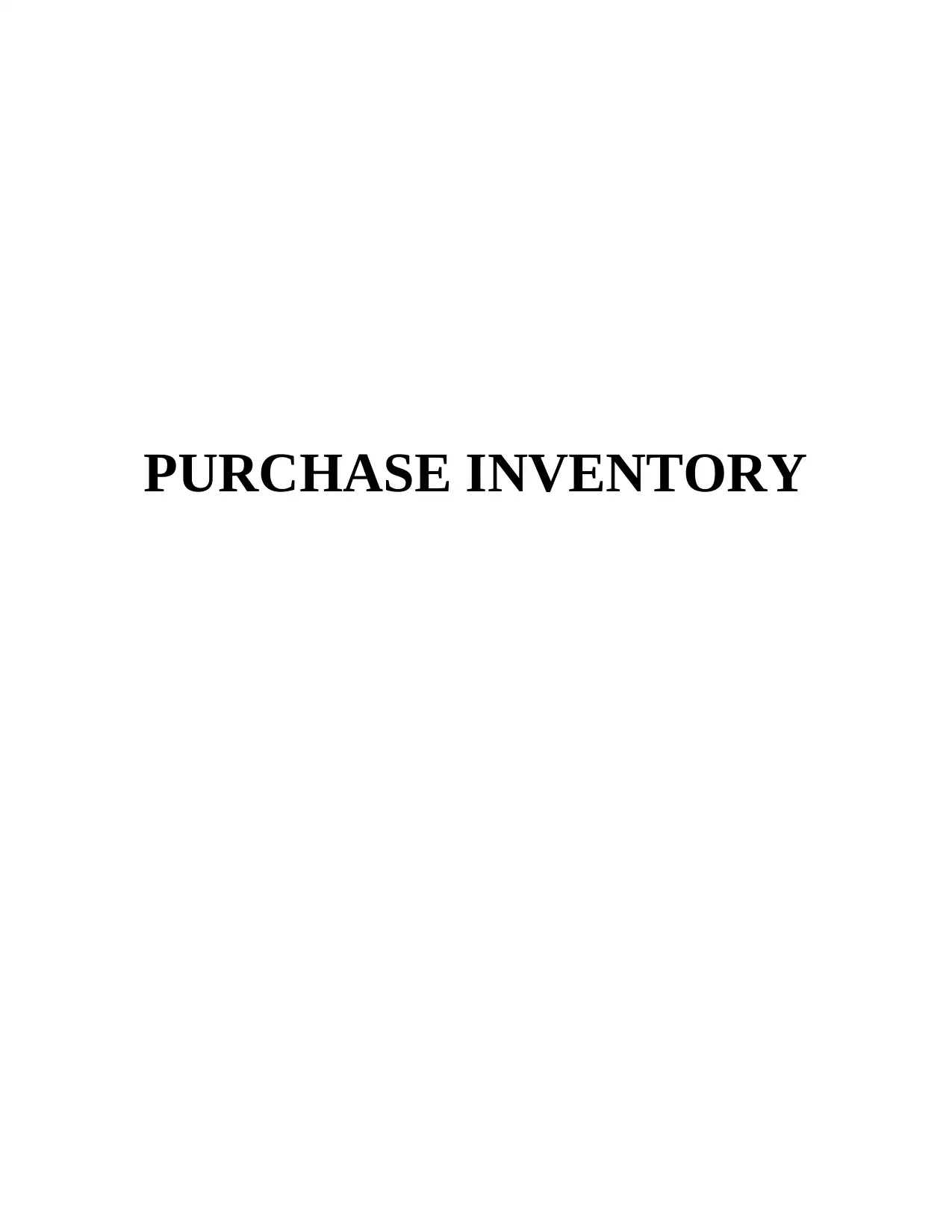
PURCHASE INVENTORY
Paraphrase This Document
Need a fresh take? Get an instant paraphrase of this document with our AI Paraphraser
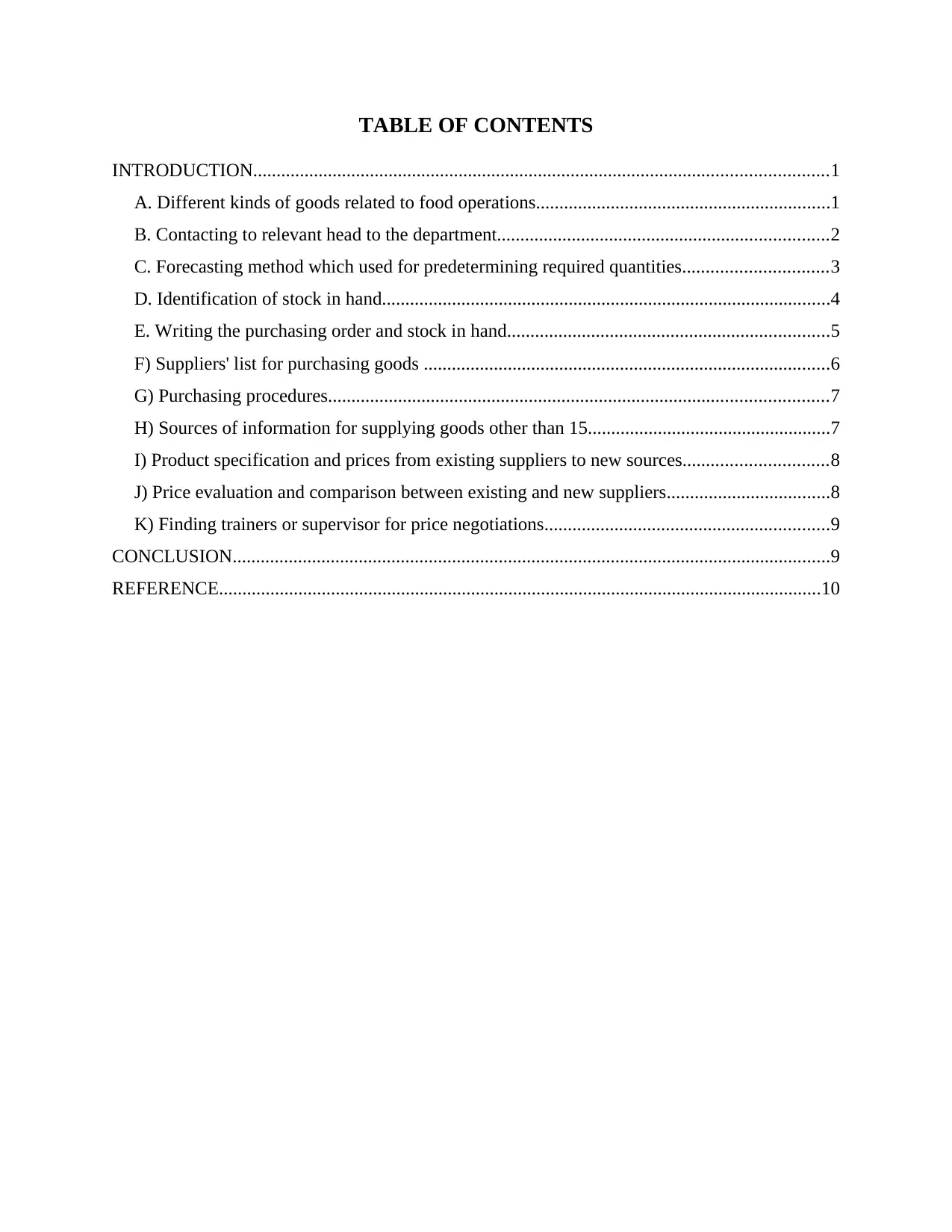
TABLE OF CONTENTS
INTRODUCTION...........................................................................................................................1
A. Different kinds of goods related to food operations...............................................................1
B. Contacting to relevant head to the department.......................................................................2
C. Forecasting method which used for predetermining required quantities...............................3
D. Identification of stock in hand................................................................................................4
E. Writing the purchasing order and stock in hand.....................................................................5
F) Suppliers' list for purchasing goods .......................................................................................6
G) Purchasing procedures...........................................................................................................7
H) Sources of information for supplying goods other than 15....................................................7
I) Product specification and prices from existing suppliers to new sources...............................8
J) Price evaluation and comparison between existing and new suppliers...................................8
K) Finding trainers or supervisor for price negotiations.............................................................9
CONCLUSION................................................................................................................................9
REFERENCE.................................................................................................................................10
INTRODUCTION...........................................................................................................................1
A. Different kinds of goods related to food operations...............................................................1
B. Contacting to relevant head to the department.......................................................................2
C. Forecasting method which used for predetermining required quantities...............................3
D. Identification of stock in hand................................................................................................4
E. Writing the purchasing order and stock in hand.....................................................................5
F) Suppliers' list for purchasing goods .......................................................................................6
G) Purchasing procedures...........................................................................................................7
H) Sources of information for supplying goods other than 15....................................................7
I) Product specification and prices from existing suppliers to new sources...............................8
J) Price evaluation and comparison between existing and new suppliers...................................8
K) Finding trainers or supervisor for price negotiations.............................................................9
CONCLUSION................................................................................................................................9
REFERENCE.................................................................................................................................10
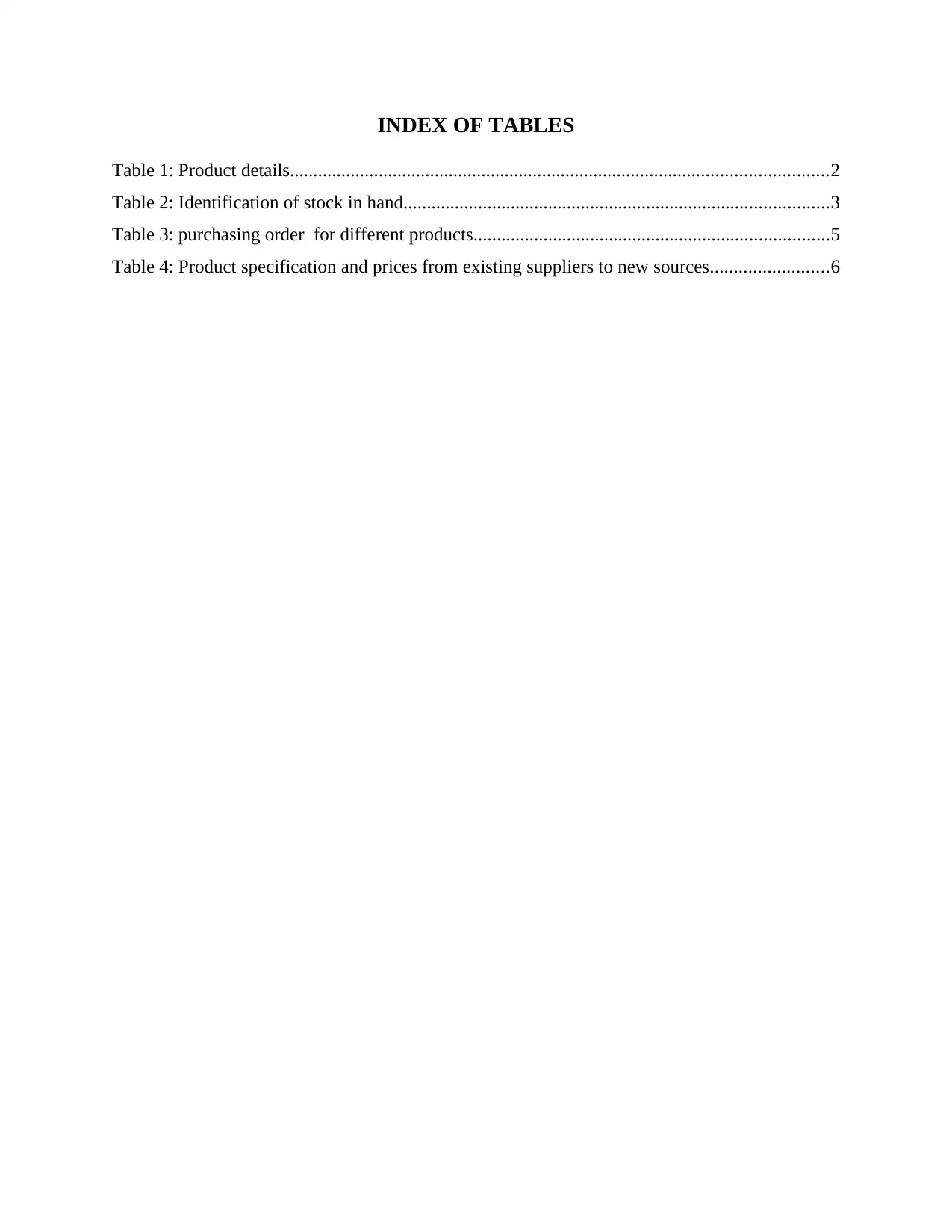
INDEX OF TABLES
Table 1: Product details...................................................................................................................2
Table 2: Identification of stock in hand...........................................................................................3
Table 3: purchasing order for different products............................................................................5
Table 4: Product specification and prices from existing suppliers to new sources.........................6
Table 1: Product details...................................................................................................................2
Table 2: Identification of stock in hand...........................................................................................3
Table 3: purchasing order for different products............................................................................5
Table 4: Product specification and prices from existing suppliers to new sources.........................6
⊘ This is a preview!⊘
Do you want full access?
Subscribe today to unlock all pages.

Trusted by 1+ million students worldwide
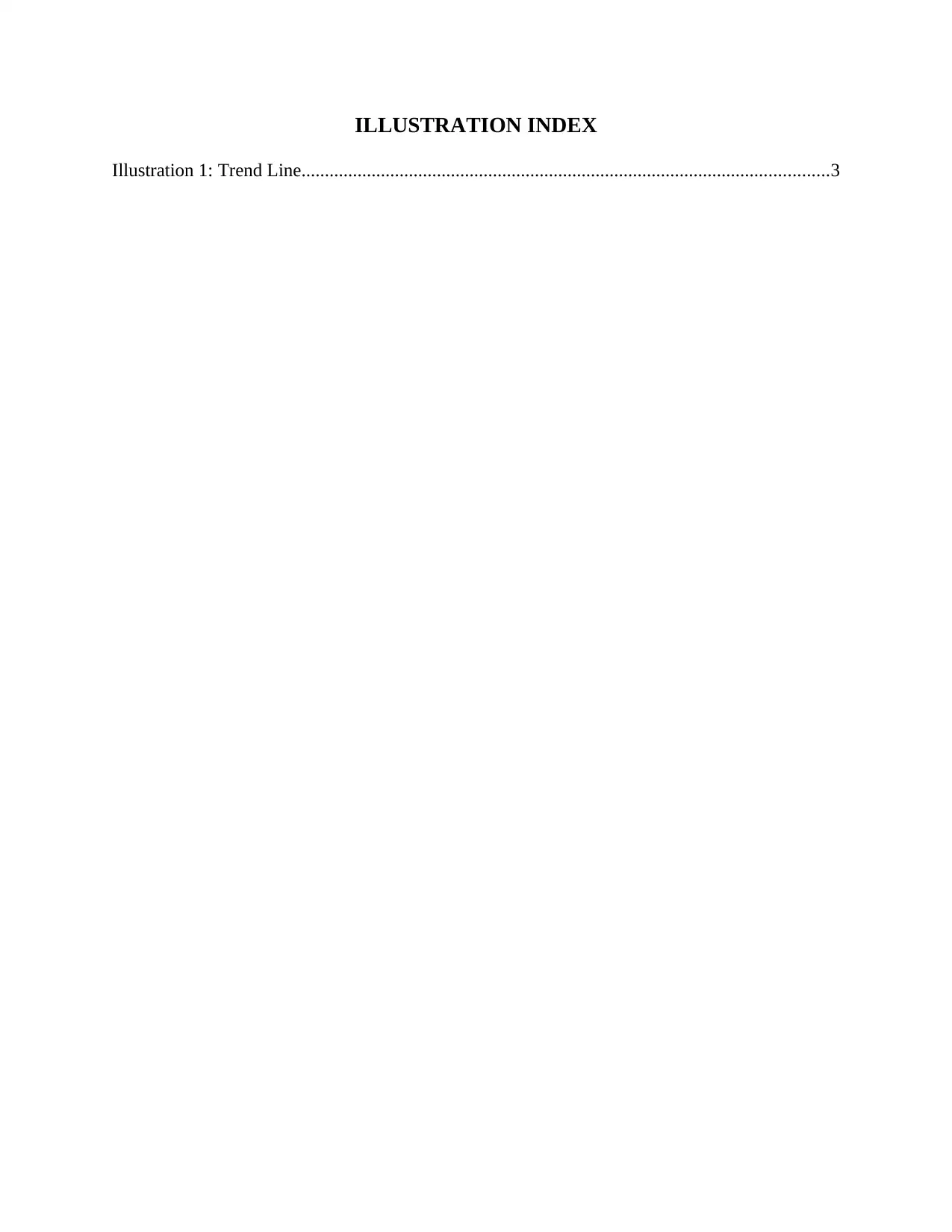
ILLUSTRATION INDEX
Illustration 1: Trend Line.................................................................................................................3
Illustration 1: Trend Line.................................................................................................................3
Paraphrase This Document
Need a fresh take? Get an instant paraphrase of this document with our AI Paraphraser
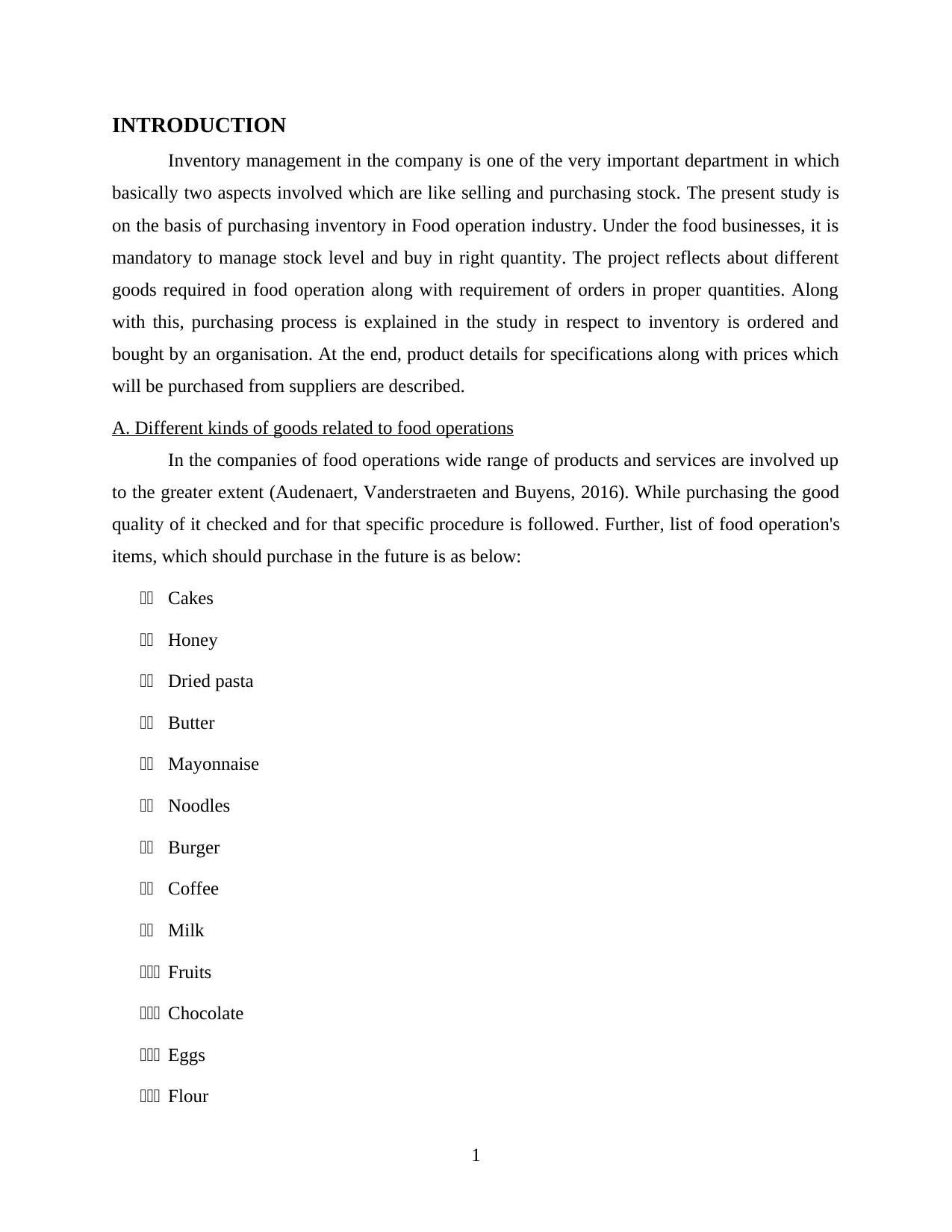
INTRODUCTION
Inventory management in the company is one of the very important department in which
basically two aspects involved which are like selling and purchasing stock. The present study is
on the basis of purchasing inventory in Food operation industry. Under the food businesses, it is
mandatory to manage stock level and buy in right quantity. The project reflects about different
goods required in food operation along with requirement of orders in proper quantities. Along
with this, purchasing process is explained in the study in respect to inventory is ordered and
bought by an organisation. At the end, product details for specifications along with prices which
will be purchased from suppliers are described.
A. Different kinds of goods related to food operations
In the companies of food operations wide range of products and services are involved up
to the greater extent (Audenaert, Vanderstraeten and Buyens, 2016). While purchasing the good
quality of it checked and for that specific procedure is followed. Further, list of food operation's
items, which should purchase in the future is as below:
11 Cakes
11 Honey
11 Dried pasta
11 Butter
11 Mayonnaise
11 Noodles
11 Burger
11 Coffee
11 Milk
111 Fruits
111 Chocolate
111 Eggs
111 Flour
1
Inventory management in the company is one of the very important department in which
basically two aspects involved which are like selling and purchasing stock. The present study is
on the basis of purchasing inventory in Food operation industry. Under the food businesses, it is
mandatory to manage stock level and buy in right quantity. The project reflects about different
goods required in food operation along with requirement of orders in proper quantities. Along
with this, purchasing process is explained in the study in respect to inventory is ordered and
bought by an organisation. At the end, product details for specifications along with prices which
will be purchased from suppliers are described.
A. Different kinds of goods related to food operations
In the companies of food operations wide range of products and services are involved up
to the greater extent (Audenaert, Vanderstraeten and Buyens, 2016). While purchasing the good
quality of it checked and for that specific procedure is followed. Further, list of food operation's
items, which should purchase in the future is as below:
11 Cakes
11 Honey
11 Dried pasta
11 Butter
11 Mayonnaise
11 Noodles
11 Burger
11 Coffee
11 Milk
111 Fruits
111 Chocolate
111 Eggs
111 Flour
1
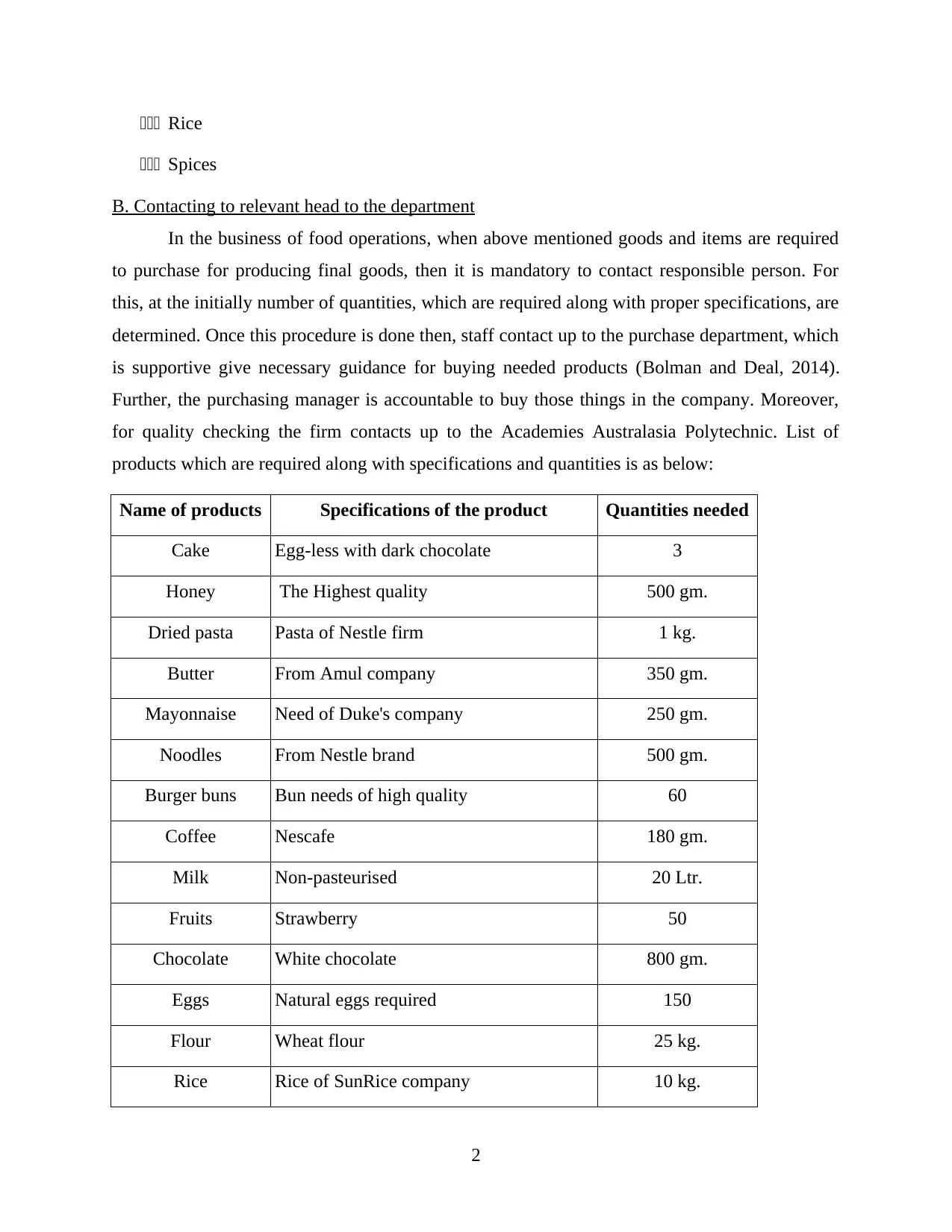
111 Rice
111 Spices
B. Contacting to relevant head to the department
In the business of food operations, when above mentioned goods and items are required
to purchase for producing final goods, then it is mandatory to contact responsible person. For
this, at the initially number of quantities, which are required along with proper specifications, are
determined. Once this procedure is done then, staff contact up to the purchase department, which
is supportive give necessary guidance for buying needed products (Bolman and Deal, 2014).
Further, the purchasing manager is accountable to buy those things in the company. Moreover,
for quality checking the firm contacts up to the Academies Australasia Polytechnic. List of
products which are required along with specifications and quantities is as below:
Name of products Specifications of the product Quantities needed
Cake Egg-less with dark chocolate 3
Honey The Highest quality 500 gm.
Dried pasta Pasta of Nestle firm 1 kg.
Butter From Amul company 350 gm.
Mayonnaise Need of Duke's company 250 gm.
Noodles From Nestle brand 500 gm.
Burger buns Bun needs of high quality 60
Coffee Nescafe 180 gm.
Milk Non-pasteurised 20 Ltr.
Fruits Strawberry 50
Chocolate White chocolate 800 gm.
Eggs Natural eggs required 150
Flour Wheat flour 25 kg.
Rice Rice of SunRice company 10 kg.
2
111 Spices
B. Contacting to relevant head to the department
In the business of food operations, when above mentioned goods and items are required
to purchase for producing final goods, then it is mandatory to contact responsible person. For
this, at the initially number of quantities, which are required along with proper specifications, are
determined. Once this procedure is done then, staff contact up to the purchase department, which
is supportive give necessary guidance for buying needed products (Bolman and Deal, 2014).
Further, the purchasing manager is accountable to buy those things in the company. Moreover,
for quality checking the firm contacts up to the Academies Australasia Polytechnic. List of
products which are required along with specifications and quantities is as below:
Name of products Specifications of the product Quantities needed
Cake Egg-less with dark chocolate 3
Honey The Highest quality 500 gm.
Dried pasta Pasta of Nestle firm 1 kg.
Butter From Amul company 350 gm.
Mayonnaise Need of Duke's company 250 gm.
Noodles From Nestle brand 500 gm.
Burger buns Bun needs of high quality 60
Coffee Nescafe 180 gm.
Milk Non-pasteurised 20 Ltr.
Fruits Strawberry 50
Chocolate White chocolate 800 gm.
Eggs Natural eggs required 150
Flour Wheat flour 25 kg.
Rice Rice of SunRice company 10 kg.
2
⊘ This is a preview!⊘
Do you want full access?
Subscribe today to unlock all pages.

Trusted by 1+ million students worldwide
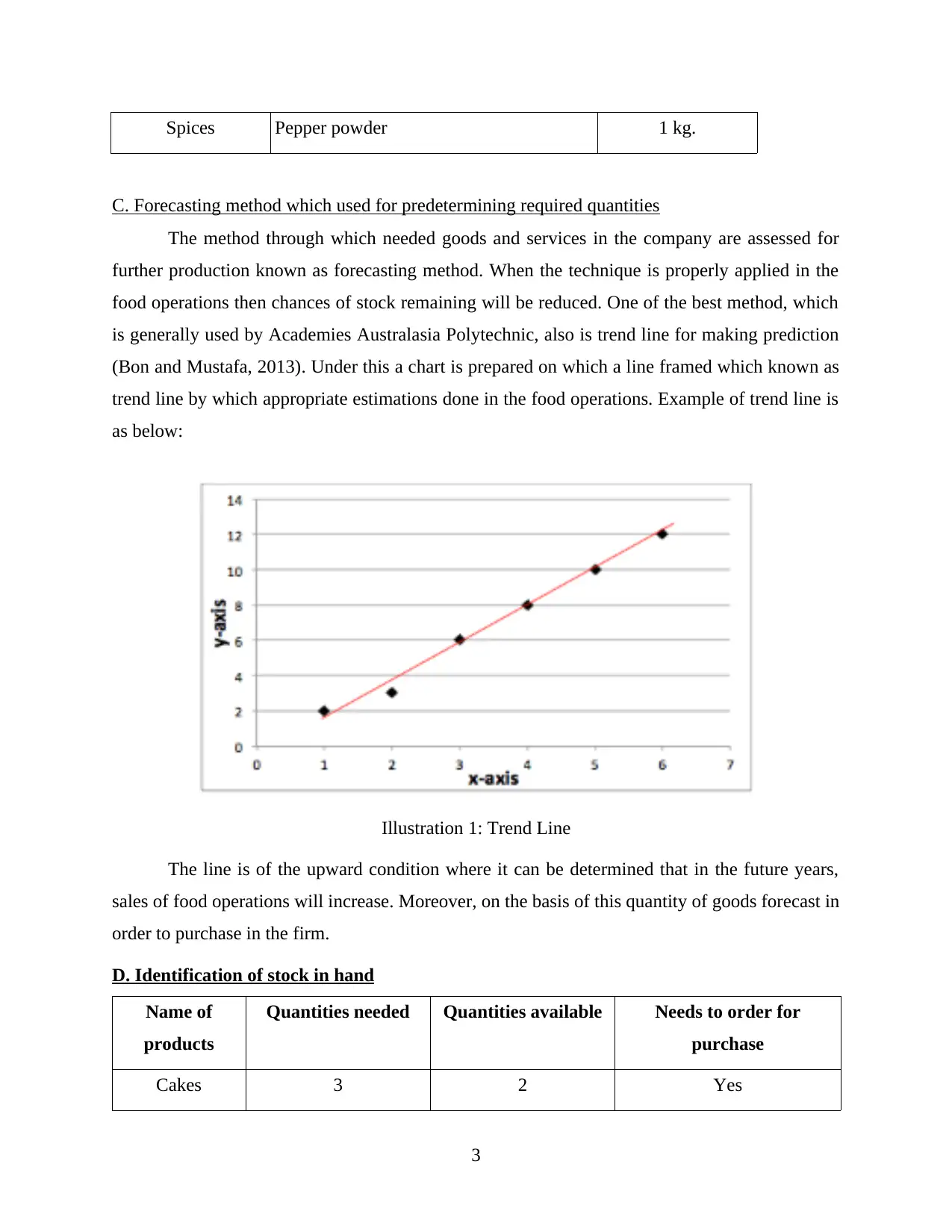
Spices Pepper powder 1 kg.
C. Forecasting method which used for predetermining required quantities
The method through which needed goods and services in the company are assessed for
further production known as forecasting method. When the technique is properly applied in the
food operations then chances of stock remaining will be reduced. One of the best method, which
is generally used by Academies Australasia Polytechnic, also is trend line for making prediction
(Bon and Mustafa, 2013). Under this a chart is prepared on which a line framed which known as
trend line by which appropriate estimations done in the food operations. Example of trend line is
as below:
Illustration 1: Trend Line
The line is of the upward condition where it can be determined that in the future years,
sales of food operations will increase. Moreover, on the basis of this quantity of goods forecast in
order to purchase in the firm.
D. Identification of stock in hand
Name of
products
Quantities needed Quantities available Needs to order for
purchase
Cakes 3 2 Yes
3
C. Forecasting method which used for predetermining required quantities
The method through which needed goods and services in the company are assessed for
further production known as forecasting method. When the technique is properly applied in the
food operations then chances of stock remaining will be reduced. One of the best method, which
is generally used by Academies Australasia Polytechnic, also is trend line for making prediction
(Bon and Mustafa, 2013). Under this a chart is prepared on which a line framed which known as
trend line by which appropriate estimations done in the food operations. Example of trend line is
as below:
Illustration 1: Trend Line
The line is of the upward condition where it can be determined that in the future years,
sales of food operations will increase. Moreover, on the basis of this quantity of goods forecast in
order to purchase in the firm.
D. Identification of stock in hand
Name of
products
Quantities needed Quantities available Needs to order for
purchase
Cakes 3 2 Yes
3
Paraphrase This Document
Need a fresh take? Get an instant paraphrase of this document with our AI Paraphraser
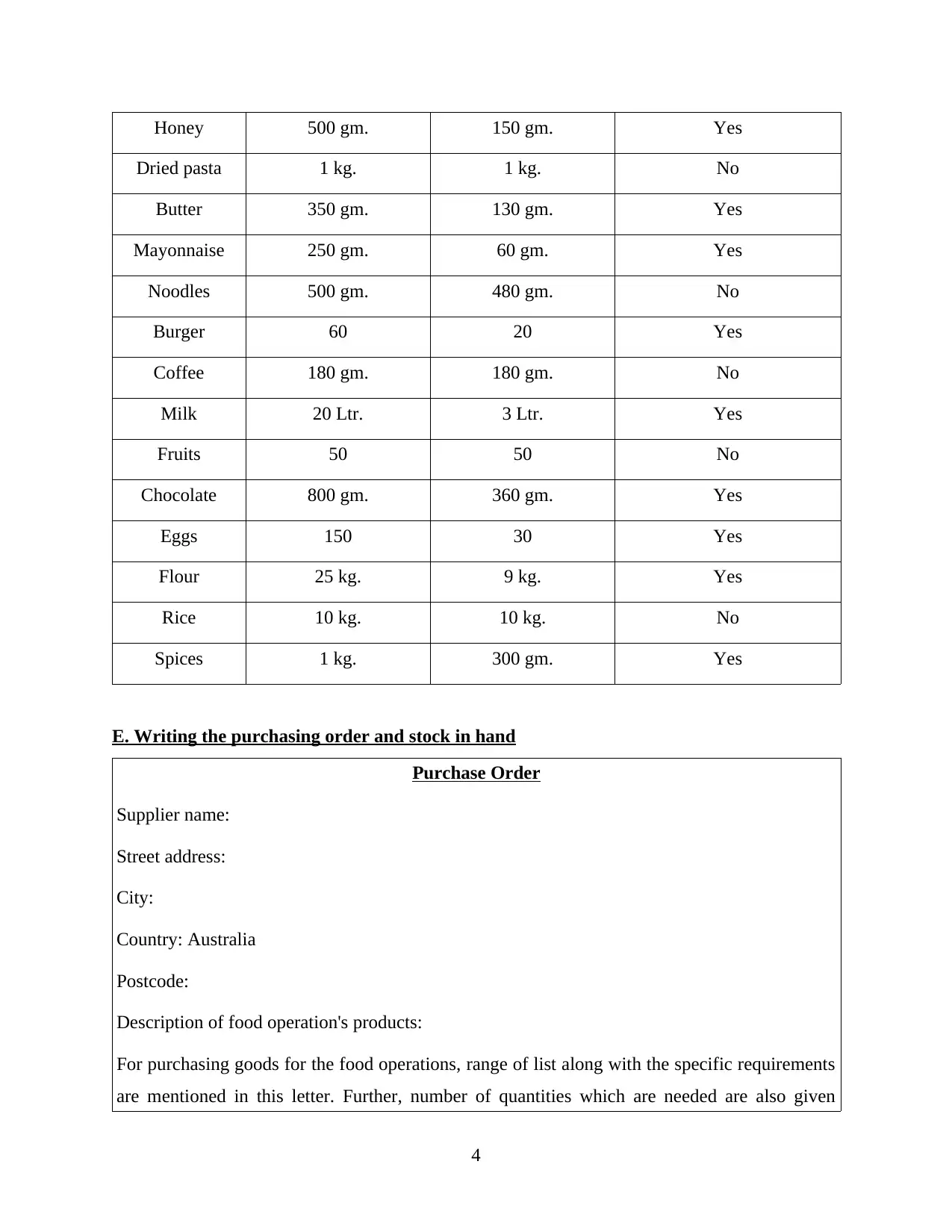
Honey 500 gm. 150 gm. Yes
Dried pasta 1 kg. 1 kg. No
Butter 350 gm. 130 gm. Yes
Mayonnaise 250 gm. 60 gm. Yes
Noodles 500 gm. 480 gm. No
Burger 60 20 Yes
Coffee 180 gm. 180 gm. No
Milk 20 Ltr. 3 Ltr. Yes
Fruits 50 50 No
Chocolate 800 gm. 360 gm. Yes
Eggs 150 30 Yes
Flour 25 kg. 9 kg. Yes
Rice 10 kg. 10 kg. No
Spices 1 kg. 300 gm. Yes
E. Writing the purchasing order and stock in hand
Purchase Order
Supplier name:
Street address:
City:
Country: Australia
Postcode:
Description of food operation's products:
For purchasing goods for the food operations, range of list along with the specific requirements
are mentioned in this letter. Further, number of quantities which are needed are also given
4
Dried pasta 1 kg. 1 kg. No
Butter 350 gm. 130 gm. Yes
Mayonnaise 250 gm. 60 gm. Yes
Noodles 500 gm. 480 gm. No
Burger 60 20 Yes
Coffee 180 gm. 180 gm. No
Milk 20 Ltr. 3 Ltr. Yes
Fruits 50 50 No
Chocolate 800 gm. 360 gm. Yes
Eggs 150 30 Yes
Flour 25 kg. 9 kg. Yes
Rice 10 kg. 10 kg. No
Spices 1 kg. 300 gm. Yes
E. Writing the purchasing order and stock in hand
Purchase Order
Supplier name:
Street address:
City:
Country: Australia
Postcode:
Description of food operation's products:
For purchasing goods for the food operations, range of list along with the specific requirements
are mentioned in this letter. Further, number of quantities which are needed are also given
4
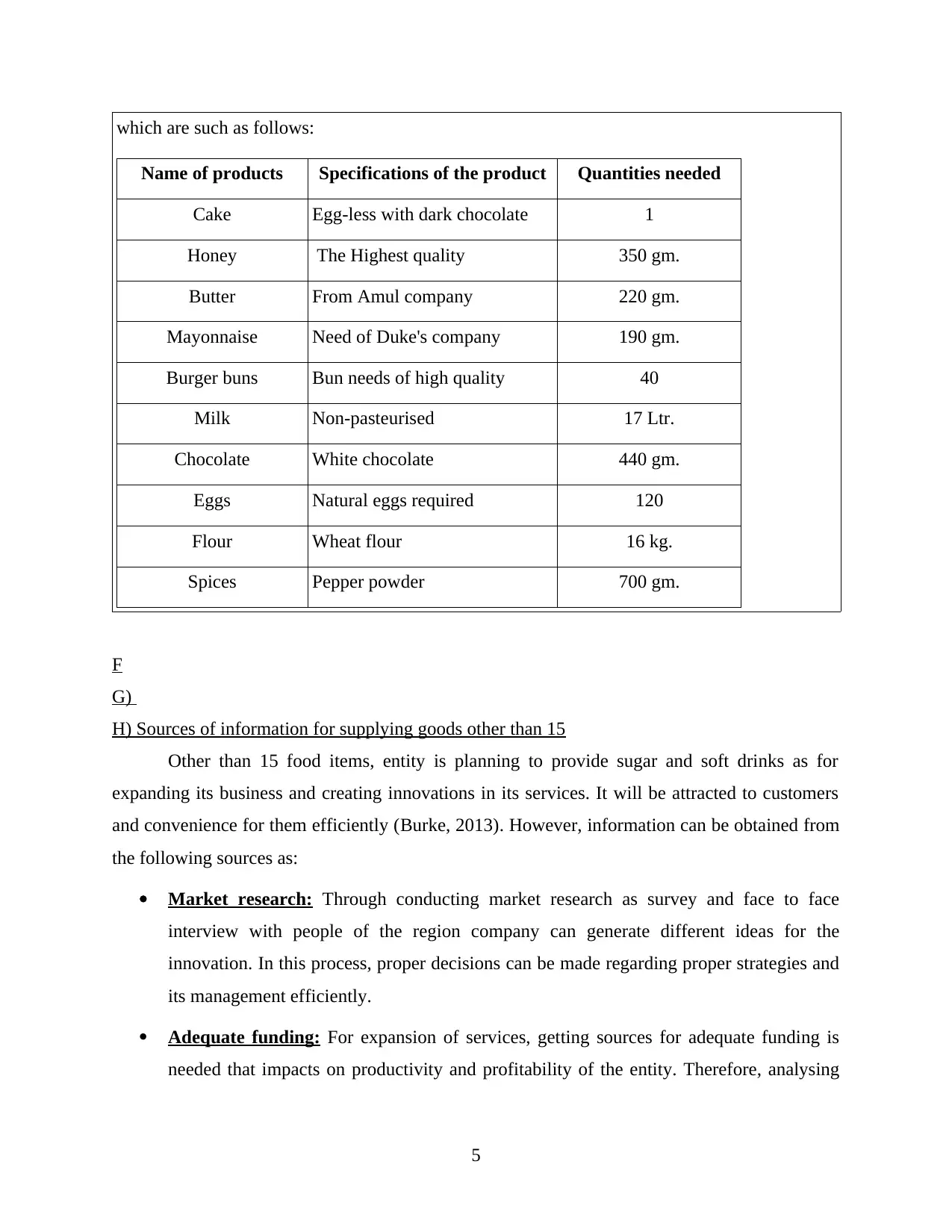
which are such as follows:
Name of products Specifications of the product Quantities needed
Cake Egg-less with dark chocolate 1
Honey The Highest quality 350 gm.
Butter From Amul company 220 gm.
Mayonnaise Need of Duke's company 190 gm.
Burger buns Bun needs of high quality 40
Milk Non-pasteurised 17 Ltr.
Chocolate White chocolate 440 gm.
Eggs Natural eggs required 120
Flour Wheat flour 16 kg.
Spices Pepper powder 700 gm.
F
G)
H) Sources of information for supplying goods other than 15
Other than 15 food items, entity is planning to provide sugar and soft drinks as for
expanding its business and creating innovations in its services. It will be attracted to customers
and convenience for them efficiently (Burke, 2013). However, information can be obtained from
the following sources as:
Market research: Through conducting market research as survey and face to face
interview with people of the region company can generate different ideas for the
innovation. In this process, proper decisions can be made regarding proper strategies and
its management efficiently.
Adequate funding: For expansion of services, getting sources for adequate funding is
needed that impacts on productivity and profitability of the entity. Therefore, analysing
5
Name of products Specifications of the product Quantities needed
Cake Egg-less with dark chocolate 1
Honey The Highest quality 350 gm.
Butter From Amul company 220 gm.
Mayonnaise Need of Duke's company 190 gm.
Burger buns Bun needs of high quality 40
Milk Non-pasteurised 17 Ltr.
Chocolate White chocolate 440 gm.
Eggs Natural eggs required 120
Flour Wheat flour 16 kg.
Spices Pepper powder 700 gm.
F
G)
H) Sources of information for supplying goods other than 15
Other than 15 food items, entity is planning to provide sugar and soft drinks as for
expanding its business and creating innovations in its services. It will be attracted to customers
and convenience for them efficiently (Burke, 2013). However, information can be obtained from
the following sources as:
Market research: Through conducting market research as survey and face to face
interview with people of the region company can generate different ideas for the
innovation. In this process, proper decisions can be made regarding proper strategies and
its management efficiently.
Adequate funding: For expansion of services, getting sources for adequate funding is
needed that impacts on productivity and profitability of the entity. Therefore, analysing
5
⊘ This is a preview!⊘
Do you want full access?
Subscribe today to unlock all pages.

Trusted by 1+ million students worldwide
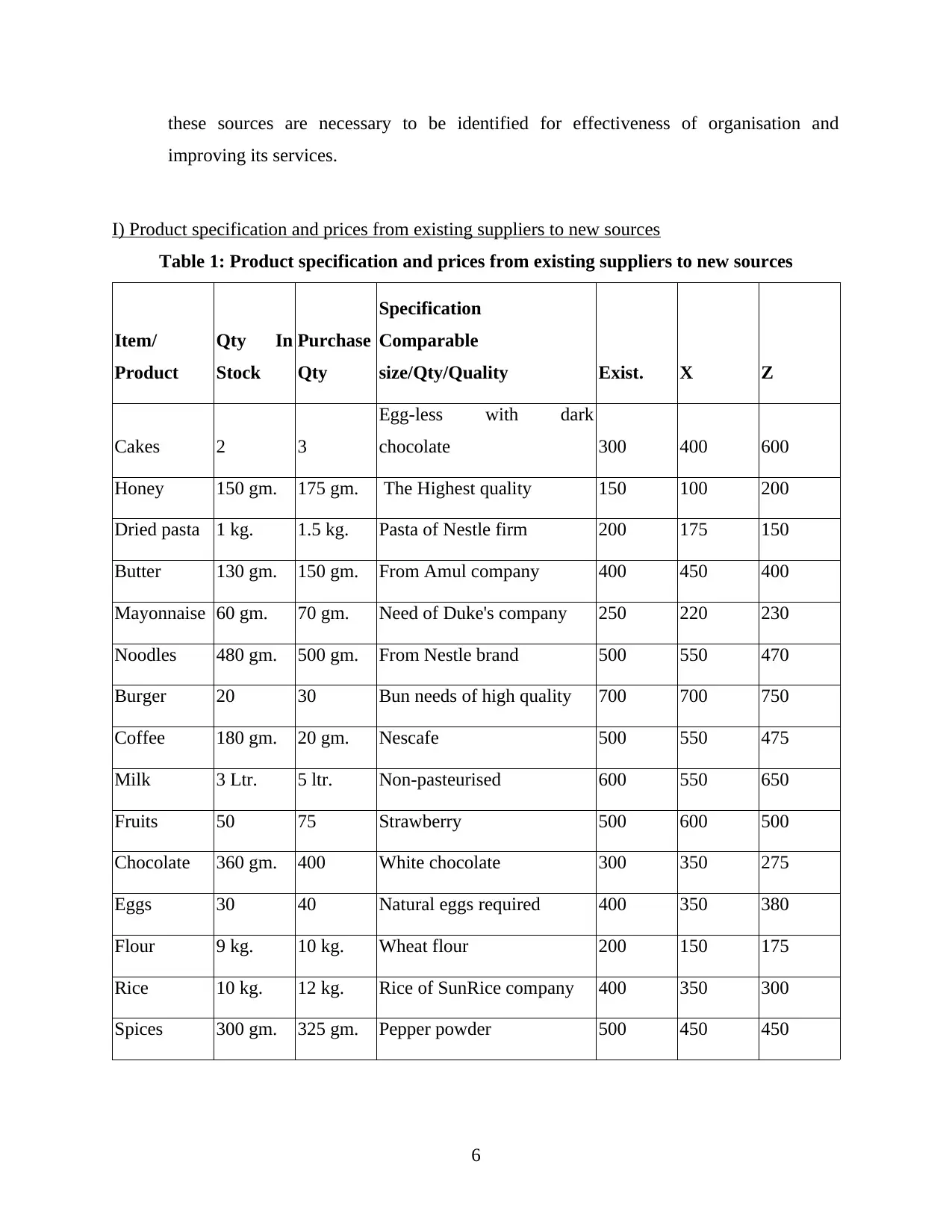
these sources are necessary to be identified for effectiveness of organisation and
improving its services.
I) Product specification and prices from existing suppliers to new sources
Table 1: Product specification and prices from existing suppliers to new sources
Item/
Product
Qty In
Stock
Purchase
Qty
Specification
Comparable
size/Qty/Quality Exist. X Z
Cakes 2 3
Egg-less with dark
chocolate 300 400 600
Honey 150 gm. 175 gm. The Highest quality 150 100 200
Dried pasta 1 kg. 1.5 kg. Pasta of Nestle firm 200 175 150
Butter 130 gm. 150 gm. From Amul company 400 450 400
Mayonnaise 60 gm. 70 gm. Need of Duke's company 250 220 230
Noodles 480 gm. 500 gm. From Nestle brand 500 550 470
Burger 20 30 Bun needs of high quality 700 700 750
Coffee 180 gm. 20 gm. Nescafe 500 550 475
Milk 3 Ltr. 5 ltr. Non-pasteurised 600 550 650
Fruits 50 75 Strawberry 500 600 500
Chocolate 360 gm. 400 White chocolate 300 350 275
Eggs 30 40 Natural eggs required 400 350 380
Flour 9 kg. 10 kg. Wheat flour 200 150 175
Rice 10 kg. 12 kg. Rice of SunRice company 400 350 300
Spices 300 gm. 325 gm. Pepper powder 500 450 450
6
improving its services.
I) Product specification and prices from existing suppliers to new sources
Table 1: Product specification and prices from existing suppliers to new sources
Item/
Product
Qty In
Stock
Purchase
Qty
Specification
Comparable
size/Qty/Quality Exist. X Z
Cakes 2 3
Egg-less with dark
chocolate 300 400 600
Honey 150 gm. 175 gm. The Highest quality 150 100 200
Dried pasta 1 kg. 1.5 kg. Pasta of Nestle firm 200 175 150
Butter 130 gm. 150 gm. From Amul company 400 450 400
Mayonnaise 60 gm. 70 gm. Need of Duke's company 250 220 230
Noodles 480 gm. 500 gm. From Nestle brand 500 550 470
Burger 20 30 Bun needs of high quality 700 700 750
Coffee 180 gm. 20 gm. Nescafe 500 550 475
Milk 3 Ltr. 5 ltr. Non-pasteurised 600 550 650
Fruits 50 75 Strawberry 500 600 500
Chocolate 360 gm. 400 White chocolate 300 350 275
Eggs 30 40 Natural eggs required 400 350 380
Flour 9 kg. 10 kg. Wheat flour 200 150 175
Rice 10 kg. 12 kg. Rice of SunRice company 400 350 300
Spices 300 gm. 325 gm. Pepper powder 500 450 450
6
Paraphrase This Document
Need a fresh take? Get an instant paraphrase of this document with our AI Paraphraser
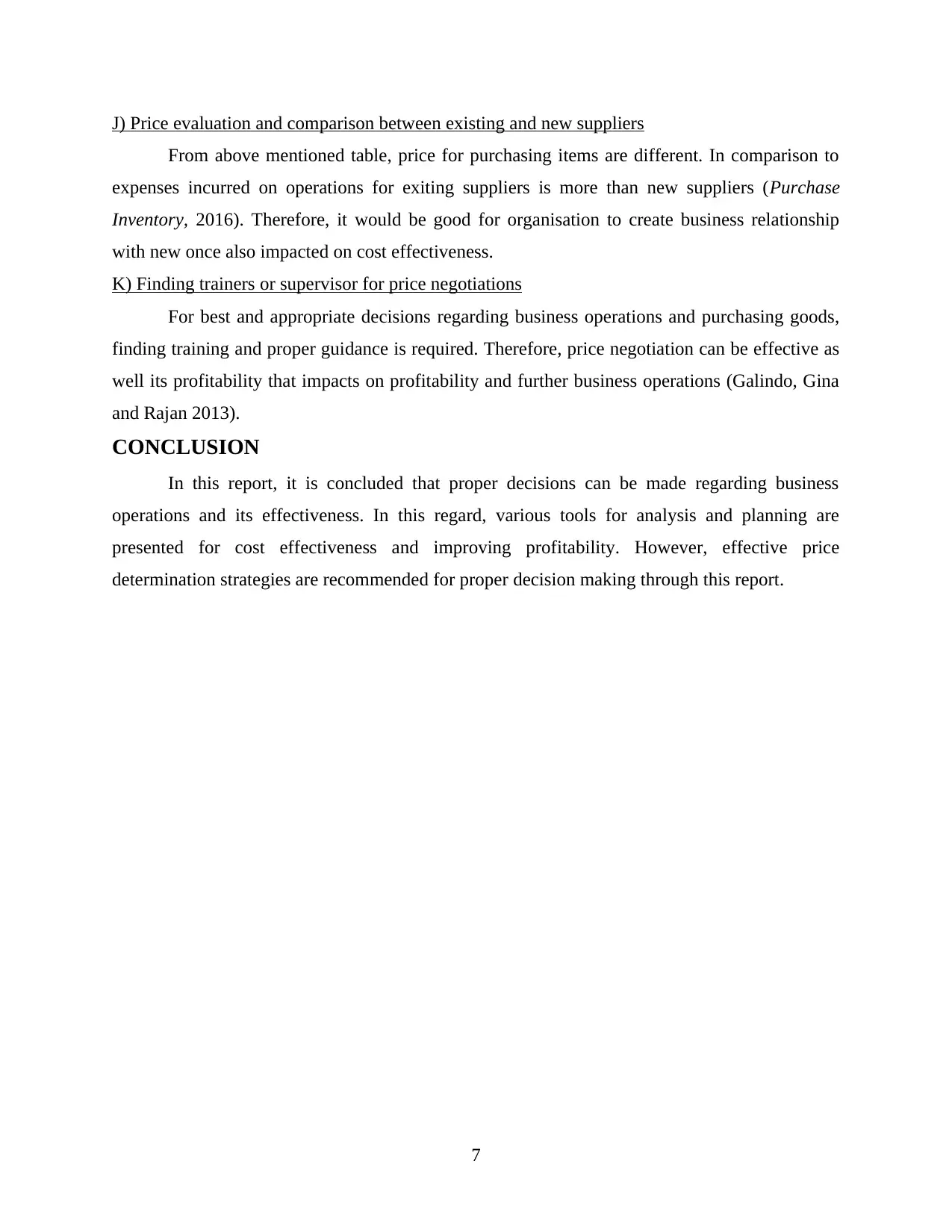
J) Price evaluation and comparison between existing and new suppliers
From above mentioned table, price for purchasing items are different. In comparison to
expenses incurred on operations for exiting suppliers is more than new suppliers (Purchase
Inventory, 2016). Therefore, it would be good for organisation to create business relationship
with new once also impacted on cost effectiveness.
K) Finding trainers or supervisor for price negotiations
For best and appropriate decisions regarding business operations and purchasing goods,
finding training and proper guidance is required. Therefore, price negotiation can be effective as
well its profitability that impacts on profitability and further business operations (Galindo, Gina
and Rajan 2013).
CONCLUSION
In this report, it is concluded that proper decisions can be made regarding business
operations and its effectiveness. In this regard, various tools for analysis and planning are
presented for cost effectiveness and improving profitability. However, effective price
determination strategies are recommended for proper decision making through this report.
7
From above mentioned table, price for purchasing items are different. In comparison to
expenses incurred on operations for exiting suppliers is more than new suppliers (Purchase
Inventory, 2016). Therefore, it would be good for organisation to create business relationship
with new once also impacted on cost effectiveness.
K) Finding trainers or supervisor for price negotiations
For best and appropriate decisions regarding business operations and purchasing goods,
finding training and proper guidance is required. Therefore, price negotiation can be effective as
well its profitability that impacts on profitability and further business operations (Galindo, Gina
and Rajan 2013).
CONCLUSION
In this report, it is concluded that proper decisions can be made regarding business
operations and its effectiveness. In this regard, various tools for analysis and planning are
presented for cost effectiveness and improving profitability. However, effective price
determination strategies are recommended for proper decision making through this report.
7
1 out of 11
Related Documents
Your All-in-One AI-Powered Toolkit for Academic Success.
+13062052269
info@desklib.com
Available 24*7 on WhatsApp / Email
![[object Object]](/_next/static/media/star-bottom.7253800d.svg)
Unlock your academic potential
Copyright © 2020–2025 A2Z Services. All Rights Reserved. Developed and managed by ZUCOL.




